In this tutorial, we’ll show you how to change negative numbers to zero while preserving positive numbers in Excel. This can be handy for financial or inventory data. By following the steps and using Excel’s functions and formatting options, you’ll be able to efficiently manipulate your data and enhance your workflow.
This Tutorial Covers:
- What is Negative
- What is Positive number
- Convert the Negative Numbers to Zero and Positives Unchanged using IF Condition
- Convert the Negative Numbers to Zero and Positives Unchanged using MAX Function
- Convert the Negative Numbers to Zero and Positives Unchanged using Custom Format Cell
1.What is Negative?
In mathematics, a negative number refers to a value that is less than zero. Negative numbers are denoted with a minus sign (-) placed before the numerical value. For example, -5 and -10 are examples of negative numbers. They represent quantities or values that are below zero on a number line. In contrast, positive numbers are values greater than zero, while zero itself is considered neither positive nor negative. Understanding the concept of negative numbers is important in various mathematical operations, financial calculations, and data analysis tasks.
2. What is Positive number?
In mathematics, a positive number refers to a value that is greater than zero. Positive numbers are denoted without a sign or with a plus sign (+) placed before the numerical value. For example, 5 and 10 are examples of positive numbers. They represent quantities or values that are above zero on a number line. Positive numbers are essential in arithmetic operations, algebraic equations, and various mathematical concepts. They are used in calculations, measurements, and representing values that indicate growth, gain, or positive attributes.
3. Convert the Negative Numbers to Zero and Positives Unchanged using IF Condition:
Suppose you have a sales spreadsheet that tracks the daily revenue generated by different products. However, due to certain data entry errors, some of the revenue values have negative numbers, which don’t make sense in the context of sales.
To rectify this, you can use the IF condition in Excel to convert the negative revenue values to zero while keeping the positive values unchanged. The IF function performs a logical test,returning a True value if the test is met and a False value if it is not.
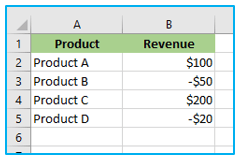
By following the steps below, you can successfully convert negative numbers to zero using the IF function:
Step 1: Apply the below formula in cell C2 and you can either copy and paste the formula or drag the formula’s fill handle to the remaining cells.
=IF(B2<0, 0, B2)
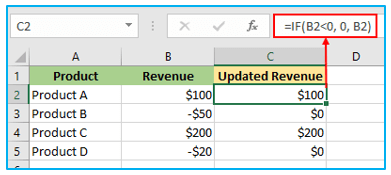
The IF function evaluates the condition B2<0, which checks if the revenue value in cell B2 is negative. If the condition is true, the function returns 0, effectively converting the negative value to zero. If the condition is false, the function returns the original revenue value (B2).
As seen in the example, the negative revenue values have been converted to zero while the positive revenue values remain unchanged, allowing for accurate analysis and calculations based on the revised data.
4. Convert the Negative Numbers to Zero and Positives Unchanged using MAX Function:
In addition to the IF function, you can also utilize the MAX function in Excel to convert negative numbers to zero while leaving positive numbers unchanged.
Here’s how you can apply the MAX function to the same dataset of revenue data:
Step 1: Apply the below formula in cell C2 and you can either copy and paste the formula or drag the formula’s fill handle to the remaining cells.
=MAX(B2,0)
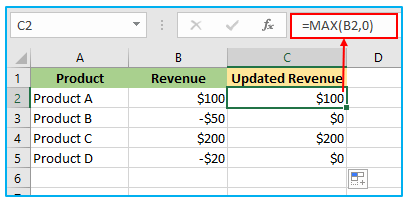
The MAX function compares the revenue value in cell B2 with zero. It returns the larger of the two values, effectively replacing any negative revenue with zero. If the revenue value is positive, the MAX function will keep it unchanged.
As shown in the example, the negative revenue values have been converted to zero using the MAX function, while the positive revenue values remain unaltered. This enables accurate analysis and computations based on the modified data.
5. Convert the Negative Numbers to Zero and Positives Unchanged using Custom Format Cell:
In addition to using formulas and functions, you can also apply a custom formatting technique in Excel to visually convert negative numbers to zero while keeping positive numbers unchanged.
Here’s how you can achieve this using custom cell formatting:
Step 1: Select the range of cells containing the revenue values (B2 to B5 in the example).
Right-click on your mouse on the selected range and choose “Format Cells” from the context menu.
You can also access “Format Cells” by Pressing the Ctrl + 1 keys on your keyboard.

Step 2: In the “Format Cells” dialog box, navigate to the “Number” tab.
Under the “Category” section, select “Custom.”
In the “Type” field, apply the below custom format:
$#,##0;”0″
Click “OK” to apply the custom formatting.
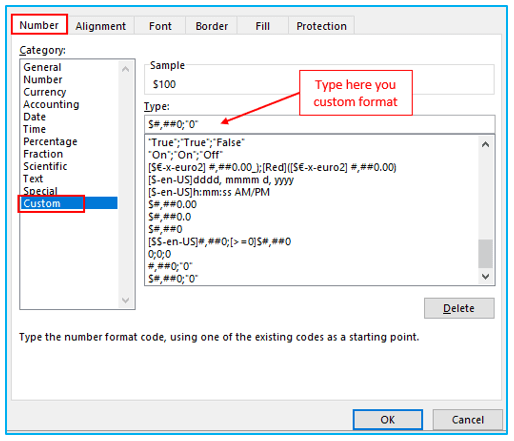
After applying the custom formatting, your revenue data will be displayed as follows:
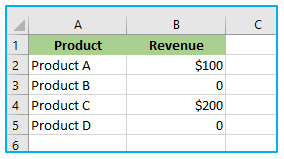
In this format, negative numbers will be visually represented as zeros while positive numbers remain unchanged.
Using the custom cell format does not require additional formulas or functions and helper columns, simplifying the worksheet structure and reducing the complexity of the formulas. It provides a straightforward and visually appealing solution to convert negative numbers to zero, enhancing the readability and usability of the spreadsheet.
Changing negative numbers to zero and keeping positive numbers unchanged in Excel provides the following advantages:
- Enables accurate analysis and computation of data.
- Improves visual clarity by removing negative numbers.
- Simplifies the data and reduces complexity in formulas.
- It makes the spreadsheet easier to manage and update.
- Reduces the risk of errors in calculations and analysis.
You may be interested:
